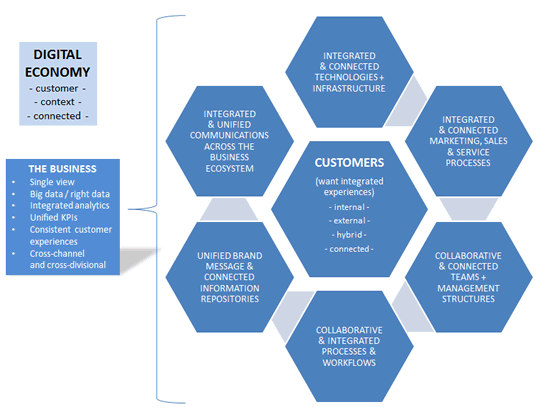 No matter how you look at it: no business can succeed if it doesn’t make sure that its customers can make their customers succeed. In the social era we have started calling this the audiences of audiences of audiences, etc. The only way to make that success happen is integration in many business functions and processes. And it requires a collaborative culture. An open letter to the CxO.
No matter how you look at it: no business can succeed if it doesn’t make sure that its customers can make their customers succeed. In the social era we have started calling this the audiences of audiences of audiences, etc. The only way to make that success happen is integration in many business functions and processes. And it requires a collaborative culture. An open letter to the CxO.
If I work for you you’re one of my customers but your people and teams are my customers too. If they don’t feel compelled to do what makes you succeed, as a manager or a business, you will not succeed and I will not succeed. They must feel comfortable and gratified in their life, work and experiences.
A customer culture is a collaborative integration culture
It’s my role, your role and that of management to create engaging experiences for employees. And, guess what: that’s what employees expect from everyone in the business, including IT as this blog post by Forrester indicates. Of course, it’s not just about IT. Employee engagement is customer engagement and is the task of everyone in the business. If you know how to engage employees, you know how to engage customers. And engagement is what makes people productive, passionate and collaborative.
Expensive words, I know. It requires change, processes and lots of time. And some employees can’t be engaged at all. That can be a sign it’s time they look for a more gratifying job.
On top of your internal customers, you have your external customers. Those that buy, for instance. Other businesses partnering with you. Consultants, bloggers and the ‘external’ workforce of freelancers, etc. Some of them can even be hybrid such as the employee in the new ways of working and the customer in a peer-to-peer relationship. In order to make you succeed, I need all of them to succeed as well. To make people buy from you, you need to be their business partner in the true sense. You need to help them achieve the goals and the very reasons why they work with you to start with.
Everything is integrated and connected. This is the age of integration and without a collaborative, holistic and unified approach it simply doesn’t work, especially in a digital transformation business reality and increasingly real-time economy.
From a marketing and customer-facing viewpoint, a unified digital marketing/business approach requires several changes:
- The customers want consistent, connected customers experiences, a challenge for marketing, customer service and all customer-facing functions, including the ‘voices’ of the company.
- The brand message and touchpoints need to be unified and consistent.
- Technologies have to be integrated (with a clear role for a hybrid and flexible approach).
- Teams, processes, communications, marketing, etc. must be integrated and unified.
- Agility needs to enable smoother and faster ways of responding to the fast pace of the customer reality and market context. Small and nimble becomes essential.
- Information, data and content are essential across all customer-facing functions and business processes overall. Information resources are connected instead of siloed. Content is available when and where it matters.
- IT and the rest of the business work closely together and various departments learn from eachother instead of reinventing the wheel.
The key focus areas are customer experiences, cross-channel and cross-divisional collaboration/optimization and, indeed, a very connected and integrated economy with several paradigm shifts happening across the enterprise and society:
- Digital transformation.
- Ubiquituous optimization.
- Überconnectedness.
- A new customer (experience) culture for “the pull customer“
It doesn’t end there. The transformational dimension reaches beyond the customer and impacts virtually all business processes that are disconnected where they should be connected and inefficient in a changed business reality where digital technologies, or rather the way they are used, have made the gaps and leaks across the organization and in the interactions between organizations and customers/employees/partners, more visible and larger than before.

The collaboration between C-level executives and the lead over digital
There is a lot to do about who will take the lead in this integrated era where digital is more pervasive and game-changing than ever before.
As you might know Gartner predicted a while back that the CMO would drive IT investments more than the CIO by 2017. And immediately the already existing discussions regarding the ‘lead over digital – and IT – debate’ multiplied.
- Some analysts made the case to get a Chief Digital Officer on board. Some say that’s the future role of the CIO, others see it as a new role.
- Other analysts said the lead over IT/digital should remain with the CIO and that the CIO had to become a business leader, an evolution that is de facto happening in many cases and as research shows. But it is far from actualized – despite the rosy picture some surveys depict – as Edwin Hageman, CEO of BT Benelux wrote in an excellent post, referring to research and market feedback (disclaimer: BT Global Services is a partners).
- Another (new) role that often gets mentioned is that of the Social (Business) Strategist, who then often gets a role in the collaborative and digital decision process as well.
- Some analysts see the lead over IT – partially – moving to the Chief Customer Officer. After all, and as explained, it’s all about the customers, both the internal and external ones. And the customer is very ‘digital’ today.
- Finally, other analysts think the role of IT and digital technology has become too important to leave it to the CIO. As Edwin points out, there is a disconnect between CIO and other members of the C-suite and there’s also a huge perception problem.
The customer/user/employee doesn’t care who leads
The lead over digital and IT in practice is a debate without a one-size-fits-all answer as each company is different and the CEO, CIO, CMO, and CxO have a name and a face. You don’t hire job titles, you hire people. And which of all these new management roles should you have in your organization? Furthermore, the customer (and his customer etc.), around whom our businesses are revolving and the debate is partially about belongs to everyone as Edwin writes. And at the same time he belongs to no one. He expects optimized experiences, respect and service and doesn’t care about who takes the lead. It’s the task of all C-level executives to understand how digital technologies enable the business to ensure those experiences, internally as well, and how they can contribute to the bottom-line in so many ways you can’t even imagine.
Integration is a matter of collaboration and collaboration a matter of processes and technologies enabling these processes in a customer-centric way, especially for the internal customers using them.
The role of the CxO in the age of integration
The role of the C-suite? To create the conditions in which it can all happen, taking into account the needs, problems, challenges and collaborative realities of everyone involved. And that’s a message for the CEO, as much at it is for those CxOs protecting their silos.
Make it happen.
Here’s the definition of management in very simple words: getting things done by getting people doing things. Enable people to do things. Get it done. Dear CEO, the CIO, CMO and all the CxOs are your allies if you allow them to and if they have that collaborative mindset required in the age of integration and digital transformation. If they don’t have it and don’t want to focus on the customer and getting their teams aligned with overall business, you know what to do.
The role of the CIO and the CMO is changing. But so is that of the CEO. Connect and integrate. You have no choice.
This blog was originally posted on www.conversionation.net and has been moved as part of an integration.

